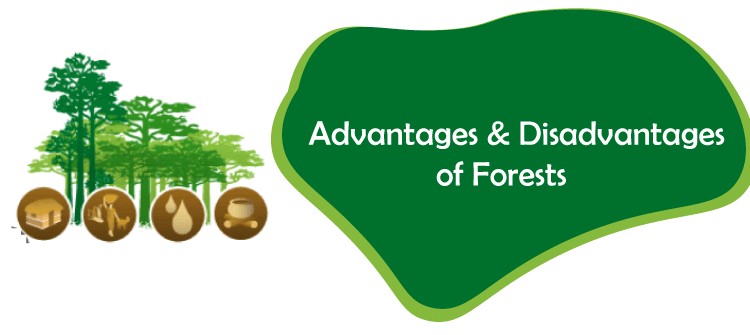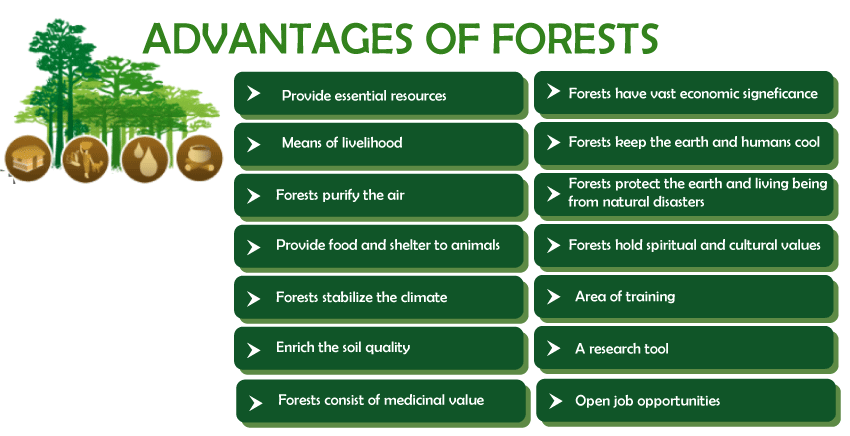Advantages and Disadvantages of ForestsCan we imagine life without trees? It's unthinkable. The answer is a big NO. We can't. Before humans came into existence, there was only land. Before the development of civilization on land or occupying of land by humans for their living and livelihood, the land was covered with trees, water, bushes, animals, and other things. The land was covered with a high density of trees that further became the habitat for various living beings, such as animals, plants, and microorganisms. This ecosystem is termed a "forest". Forests play a vital role in the economy, global environment, and economy. Forests can develop wherever the average temperature exceeds 10 °C in the warmest month, and rainfall exceeds 200 mm annually. In any area with conditions above this range, a variety of tree species are grouped into several forest types determined by the specific conditions of the environment there, including the climate, soil, geology, and biotic activity. 
"A land of full of trees preserving some or all primitive of wildness (wild animals), different kind of plants and tress that collectively create a special environment or complex ecosystem is called as forest." Types of forestsAll over the world or on a global scale, forests are categorized on their distance from the equator and shaped by the amount of precipitation and solar radiation influenced by latitude. But the climatic and environmental conditions decide what kind of animals will survive in forests. There are three types of forests based on latitude: temperate, boreal, and tropical.
Forests are means of human survival from birth to death as the air we use from birth and wood we burn after death come from forests. There is a huge list of the dependencies of forests, including human livelihoods, prevention of soil erosion, watershed protection, mitigating climate change, and many more. Therefore forests have various advantages and disadvantages in today's life. Let's discuss the following: Advantages of forestsBefore human came into existence, there was only forests on the land, endless forests with various species and numerous advantages following: 
Provide essential resources Our daily essentials are our house, furniture, the food we eat, and the products we use are derived from forest resources. Throughout the world, crores of families rely on forests for their existence. Means of livelihood Forests are means of livelihood from all over the world because human life on earth began as forest dwellers. People worldwide depend directly or indirectly on forests for their subsistence and income, especially people living in villages and in extreme poverty. Humans gather food from forests and depend on them for all their needs. Humans cut forests and sell wood for money and collect wood from forests as fuel for free. Wood is an essential fuel for cooking and heating in rural populations, including smaller stem that is easy to collect and carry. Even for building houses, wood is required, and forests provide work for humans on daily wages. Forests purify the air. Oxygen is the lifeline of a loving being on earth, provided by trees. Trees and plants are the only ones that intake harmful gas (carbon dioxide) and exhale purified gas (oxygen) which is essential for living. Thus, forests act as an instrumental tool in purifying the air and reducing harmful gases (greenhouses gases, carbon dioxide, carbon monoxide, etc.) in the environment responsible for global warming. Provide food and shelter to animals Forests are home to numerous species, giving them habitat and food. Forests support numerous ecosystems, including 90% of the earth's species, such as deer, elephants, insects, butterflies, lions, leopards, crocodiles, turtles, birds, snakes, monkeys, all other amphibians, etc. All these animals live in forests on land, water (rivers), and streams in forest areas. Forests stabilize the climate. Trees and plants are the most important factor in stabilizing the climate, and forests consist of many trees that can regulate regional temperature by absorbing the sun's radiant heat. They are the reason for promoting cool climate and rainfall as an effect of evapotranspiration. Enrich the soil quality Plants shed their leaves and small branches with fruits and seeds that decompose with time in the soil and increase the nutrient value of the soil. Usually, forest soil is of super fine quality because plant and tree roots break the soil into finer particles that increase water infiltration into the soil. The roots help reduce water flow on the surface by absorbing the water and minimizing soil erosion. Forests consist of medicinal value. Forests have extensive plant and animal life used in the medical industry, as few plants are herbs used in medicine making. A few animals, like snake venom, are used in making cancer and other disease drugs. Many drugs are extracted from animals and plants in the forests for diverse medical treatments. Forests are like a treasure of gold, diamonds, and money in the form of plants and animals used in the medical industry. Forests have vast economic significance. Forests are a resource of income as they provide humans with food and timber utilization in construction as a raw material and making of other products. Few forests are converted into wildlife sanctuaries and national parks to increase tourism worldwide. They include areas with beautiful natural sceneries and wildlife inhabiting the forests. Forests contribute to the country's and state's economic value and increase gradually over the years. Forests keep the earth and humans cool. The shade of tree is a real shade that gives earth and humans cool vibes. Trees and plants are a source of naturally purified air with a shade that reduces the need for electric fans or air conditioners. It reduces the natural and electric heat produced by electric items in city life. It reduces the heat of the land and regulates regional temperatures. Forests protect the earth and living beings from natural disasters. As we know, forests prevent soil erosion, and long roots grab the underground earth soil that helps prevent landslides and earthquakes. Mangrove forests are the best example, as they act as a natural buffer by stabilizing shorelines and reducing the power of waves. Due to this, these forests prevent the damaging effects of storms and tsunamis regarding the protection of coastal communities. Forests hold spiritual and cultural values. Forests consist of specific plants, trees, animals, and rocks (dens or caves) that have a symbolic meaning in a certain culture and depict folklore, art, and traditional practices. Till now, few un-socialized tribes, apart from the city or village life, live in forests by protecting their culture and traditions of tribes. Some forests have temples and traces of ancient times. Area of training Its army or soldiers protect the people of the country. In training army soldiers, forests act as a live training ground or a model where they do the live practice of saving our lives. Soldiers are made to survive in extreme conditions of the forests in their training phase to make them avail of all the situations. A research tool Internationally forests are considered a research tool that proves a research environment. The Historians, researchers (biological, geographical, psychologist, agriculture and food, archaeological, etc.), and learners will do their research in forests. The study of forests is included in studies as a subject or comes in environmental study. Open job opportunities State and central governments take care of forests and fetch wood from them (timber) by chopping millions of trees every year to meet the need of human beings and sell them in the market. For this work, they appoint people as a worker for different posts. It also open work opportunities for illiterate people as a labor force. Wildlife sanctuaries and national parks also provide jobs. The government has established a separate department to protect the forests, i.e., the "forest department, " which appoints officers to maintain and secure them. Disadvantages of forestsNo doubt that forests are the agency of botanical life on earth acquired the major portion of the earth. They have been an essential part of surviving on earth, but they have a small portion of another side, which can be dangerous. Here are some of the disadvantages of forests are: 
Wildfires are common According to forest survey reports, fire events will increase by 50% at the end of the century due to extreme climate crises and land usage changes. Mostly dry deciduous forests are highly prone to fire events compared with evergreen, semi-evergreen and montane temperate forests. In India, 36% of the forest area is prone to forest fires. Not only does it harm the climate, but it also puts the lives of wild animals in danger and can reach the houses nearby, damage human property, and take lives. Throughout the world, there have been the largest world fires in history:
Note: According to the state of forests report, India has reported forests fire (345 989)from November 2020- June 2021.The destruction of forests can destroy the habitat of animals and birds. Forests are home to various species, including birds and animals, which use trees as their home and find themselves with nowhere to go. In the past few years, cutting trees has raised this problem. If we break the home of birds and animals, they will start searching for a new home and live with humans. For example, due to cutting forests, money moved toward city life and wreaked havoc in the city. People have also died and live in fear due to the conditions of monkeys. Unknowingly some animals like lions, tigers, and elephants moved toward the city in search of food. This leads to a panic situation for animals and humans too. A great hideout In the past, forests are optioned by criminals, terrorists, and insurgents as a wonderful hideout. Dense forests are best where they make their hideouts after committing a crime because normal people or police can't reach them. It's the worst reality that major crimes are conducted in forests, such as murder, smuggling, eloping, and hiding from the police. Being expensive to maintain To preserve the bio-diversities or greenery, we must preserve trees, especially exotic ones. This process needs much attention and time from the people who maintain the forests. But this process of maintenance is difficult and expensive. Give way to floods We have learned that trees hold the flow of water coming down from mountains during floods and typhoons and absorb them too, but if trees were not there, the river would overflow, and a flood situation would arise that would result in property loss and lives. Due to fewer trees in the past year, many areas have faced flood disasters in the rainy season. Government schemes or plans under disaster management get to succeed with tress. Deforestation acts as a curse. We are leading toward deforestation in fulfilling our needs, causing a domino effect on the whole planet. It includes:
Conclusion: Forests are the gift of nature and earth that always act as the giver. They are essential for the survival of human beings. If we can't preserve forests, it will lead to an empty and meaningless world. Forests are the heart of the earth that holds the story of the earth's survival since the universe came into existence. |
 For Videos Join Our Youtube Channel: Join Now
For Videos Join Our Youtube Channel: Join Now
Feedback
- Send your Feedback to [email protected]
Help Others, Please Share










